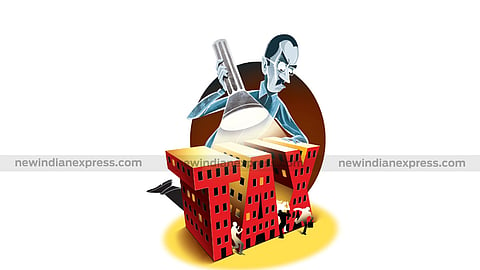

NEW DELHI: The government is likely to make the new tax regime more lucrative by extending the exemption slab from R3 lakh to R 4 lakh, sources told TNIE. In addition to this, current standard deduction of R50,000 may be increased to R75,000.
“The government may move towards a ‘Single Hybrid Tax Regime’ as the new taxpayers are already in the new tax regime. It is expected that the exemption slab in the new regime may be extended from the present R3 lakh to R4 lakh at least,” a top source said.
“Standard deduction for salaried taxpayers may be increased. Standard deduction was introduced in 2019 and now it is expected that it should increase to at least R75000,” he added. Established taxpayers with incomes exceeding R15 lakh continue to favour the old tax regime.
Sources suggest that the government may introduce incentives to encourage a transition to the new tax regime for these taxpayers. One potential change could be the introduction of a new tax slab for incomes between R15 lakh and R18 lakh, with a proposed tax rate of 25%.
“These changes will help in more cash flow in the hands of salaried class. It will boost consumption and help GDP growth of the country, thus also promoting employment generation to cater to the increased demand,” said Vivek Jalan, Partner with Tax Connect Advisory. The Government of India launched a new optional tax regime on April 1, 2020, for individuals and Hindu Undivided Families (HUF).
In the Budget 2023, the new tax regime was established as the default tax system, requiring individuals who wish to opt for the old tax regime to make a selection. The new tax regime has expanded the taxation framework to include six tax slabs, with rates ranging from 0% to 30%. The highest tax rate applies to income exceeding R15 lakh.
The old tax regime is beneficial for individuals who can take advantage of various deductions and exemptions. The choice between the old and new tax regimes largely hinges on the amount of deductions one can claim.
The greater the deductions, the more tax savings one can achieve with the old regime; otherwise, the new tax regime may be more advantageous, say experts. A significant distinction between the two regimes is the removal of most exemptions and deductions in the new tax regime. Notable deductions that are eliminated include those under Section 80C (up to R1.5 lakh for investments in EPF, PPF, ELSS, life insurance premiums, and the National Pension System), Section 80D (health insurance premiums and specified medical expenses for senior citizens), Section 80CCD (1B) for additional NPS investments, as well as deductions for House Rent Allowance (HRA), Leave Travel Allowance (LTA), and interest on loans for self-occupied properties. Additionally, losses from rental properties cannot be offset against other income categories and cannot be carried forward.
However, some deductions are still available under the new tax regime, such as a standard deduction of R50,000 and deductions for employer contributions to the NPS under Section 80CCD(2). Moreover, resident individual taxpayers with an income of up to R7 lakhs are not required to pay any tax due to the rebate under Section 87A.